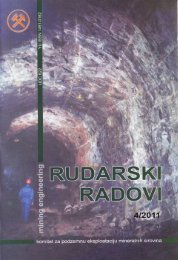Institut za rudarstvo i metalurgiju Bor
Institut za rudarstvo i metalurgiju Bor
Institut za rudarstvo i metalurgiju Bor
Create successful ePaper yourself
Turn your PDF publications into a flip-book with our unique Google optimized e-Paper software.
A characteristic of these rocks is serpentini<strong>za</strong>tion-serpentinited<br />
Peridotite and serpentinites.<br />
Hydrothermal processes of tertiary<br />
magmatism caused magnesite venation and<br />
wires. The processes of decomposition are<br />
expressed in the serpentinites (nontronite,<br />
wire magnesite). Tertiary magmatism indicates<br />
granite Intrusions followed by the<br />
volcanic processes tracked in several sequences,<br />
when volcanic rocks (daciteandesite,<br />
rhyodacite, pyroxene-amphibolite<br />
andesite, tuffs and conglomerates) were<br />
formed. The thermal waters occurred in<br />
these described rocks [7].<br />
Reservoir of mineral waters constitutes<br />
complex of carbonate Mesozoic and<br />
Paleozoic rocks. Most likely this is a Triassic<br />
limestone, given that they were<br />
briefly exposed to erosion during the Jurassic<br />
and lower Cretaceous. Water in the<br />
reservoir originates from the semi-arid<br />
climate (20,000 yr.) and have a temperature<br />
of about 120 0 C [3].<br />
The springs of thermo-mineral water of<br />
Banjska are located on the land of St. Sava<br />
monastery, on the south-eastern slopes of<br />
Rogozna. The occurrence of thermo mineral<br />
water of Banjska is directly related to<br />
fault structure, so that they appear to contact<br />
serpentinites and cretaceous flysch<br />
(Fig.1.). In the village there were noted a<br />
total of 4 springs, but 3 of them are<br />
capped. Two of them are in the village,<br />
with yield of Q1= 1 l/sec, Q2 = 0.5 l/sec (in<br />
the courtyards of the private houses), the<br />
third is in the Spa Pool, with the yield<br />
Q3 = 1 l/sec, and the fourth is at the monastery<br />
(Milutin city) that is located on the<br />
tufa terrace, with the yield of Q4 = 5 l/sec.<br />
Thickness of tufa terrace is > 20 m.<br />
It was created by the separation of<br />
calcium - carbonate from the thermo mineral<br />
water spring at the monastery, on the<br />
basis of which it is interpreted the genesis<br />
of mineral water. In zone Banjska there<br />
were extracted phenomenon of marble and<br />
limestone on the surface of the terrain.<br />
Thermo-mineral water is formed in these<br />
rocks. Serpentinites are a transit zone and<br />
affect the chemical composition. Warming<br />
water is directly related to tertiary volcanic<br />
process [5].<br />
From the monastery, according to the<br />
latest available data, a yield about 5 l / s,<br />
with temperature of 54 o C. Almost certainly<br />
it could be said that the early yield<br />
was much higher, when a large amount of<br />
deposited tufa is shown. This source is<br />
capped for the spa, but due to a damage of<br />
piping, water does not come to the spa.<br />
The observed yield regime capacity<br />
and water temperature in the period August-November<br />
2004 and September-<br />
November 2008 in the spa pool is stable,<br />
indicating by deep siphonal circulation of<br />
thermal waters. Yield is little changed in<br />
interval of 0.8-1.2 l / s. Water temperature<br />
is 40.5 0 C [6].<br />
No 1,2010. 162<br />
MINING ENGINEERING



